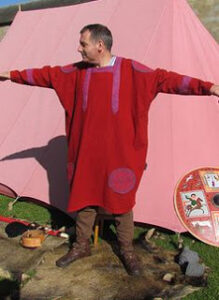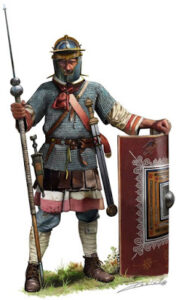Recently I was re-reading an article a friend of mine wrote about military clothing being too hot. One of the contributing factors to this is that the design of military uniforms is often influenced by civilian conventions. It is usually a fairly conservative interpretation too so a design will often be based on conventions at least a generation old!
If we look back in history we see that for many centuries the outdoor wear of a soldier, hunter or farmer consisted of a tunic, cloak and (usually) some form of leggings. Sometime about the 18th century it close fitting jackets became more common. The cloak persisted a little longer but was eventually replaced in military circles by the greatcoat and then the parka. By the 20th century what the military was still calling a tunic was effectively a sort of close-fitting sports coat. As the use of body armour became more common soldiers were expected to wear their tunics/ combat jackets underneath it, and not surprisingly this was hot and uncomfortable. Recently there have been attempts to address this with “underarmour shirts”. Effectively these are sweatshirts with camouflaged sleeves. Most that I have seen appear to be fairly snug fitting. A better solution would be a smock that can be worn over the armour.
Many of us are not restricted by military dress regulations. If things go really pear-shaped we are going to value functionability over fashion or convention.
Following the train of thought I was once again looking at the clothing of Roman legionaries. Roman soldiers operated all the way from the border of Scotland to what is now Israel. The basic clothing they used apparently worked in all these climates did not change much over several centuries.
Cloaks have been discussed in several previous blogs so today I will look at the Roman tunic. I’ll retain the Latin term “tunica” to distinguish it from the Saxon/ Viking/ Medieval variant.

One of the things that strikes you about the tunica is how simple it was. A tunica is just a large rectangle of cloth, or a pair of rectangles sewn together. The cloth was usually woven on a vertical loom and then cut so the selvedge edges were the bottom or top and bottom, minimising the need to hem. If you are not much of a tailor, this is the garment for you!

Typically a tunica did not have sleeves, its width being sufficient that the shoulder edge drapes over and covers the upper arm. Short sleeves were made from simple rectangles of cloth. The Romans considered long sleeves to be a bit wimpy and Julius Caesar was mocked for preferring a long sleeved tunic. Colder climates and the influence of other cultures seem to have changed this attitude over time. Long sleeved tunics were cut from a single piece of cloth, with ample volume beneath the armpits. Sometimes they were woven as a cross-shaped piece of cloth. When the sleeves were made from separate pieces they probably were cut to create the same shape.

The other thing that is notable about the tunica is that it is big. Records show tunics were made from cloth 1.55m by 1.4m. (60 x 55”). Unbloused, a tunic would hang to the wearer’s knees. One military punishment was to take a legionary’s belt and make him wear the tunic in this fashion. The belt was considered a symbol of soldiering so prohibiting its wear was a humiliation. It may have been that this was seen as demasculinizing since the tunic would have resembled to longer tunics worn by Roman women. Making an offender dress in women’s clothing is another recorded punishment.
Worn correctly the tunic was belted and gathered up above the belt so it was mid-thigh length. Why was the tunic so long? Perhaps the intention was that it could also serve as a nightshirt. However, there are records of tunics being shortened with tucks at the waist. At least one Roman writer suggests that the tunic should simply be made shorter in the first place. This page for re-enactors suggests creating a tunica from two rectangles of 36-48” by 30-48”.
The fit of the tunica is interesting. In the Mediterranean countries it probably allowed air to freely circulate around the body. Even when wearing armour there would have been some circulation to the underarm region, without the need for modern contrivances such as zippers. Combined with a cloak the folds of the tunic probably trapped air and kept the wearer warm.
The large neck opening of the tunica seems to have been less liked by some Romans. There are illustrations and records of the tunica being knotted at the back of the neck to restrict the opening. One of the reasons for the large opening was that during tasks such as manual labour the tunic was sometimes worn with one shoulder bared. The wearing of a neck scarf was very common, particularly when armour was worn. The scarf would prevent the armour chaffing the neck. The scarf may also have served a function similar to the detachable collars of later centuries. Notably tunics worn by later and more northern cultures had less of a neck opening.
The tunica was not used in isolation, of course. Unless it was very hot an under-tunic of the same basic design would have been worn. This would have provided additional insulation and reduced the need to launder the outer garment.


The tunica was long enough that it did not need to be worn with leggings. The Romans considered trousers to be barbarian and effeminate. The practicalities of military life overrode this prejudice. Bracae were breeches that reached to just below the knee. Trajan’s column shows infantry legionaries bare legged but cavalry and officers wearing bracae. Long trousers or a form of gaiter or puttee seem to have been adopted where conditions required.

Some form of lower underwear was used. If the legionary was wearing bracae or trousers the lower part of the undertunic might have been gathered around the loins, as was common with the undershirt in medieval times. There are records of some form of underpants, “subligariorum”. Short, linen bracae-type garments are known. Loincloths were also used. The example shown in the picture below was probably “outerwear” for athletes and gladiators, a soldier wearing something less bulky and simpler.

On the theme of simple to create clothing, I came across this illustration of a Japanese loincloth. Simply a rectangle of cloth 6-14” wide with a ribbon or tape sewn to one edge. The second illustration is a curious variant with a bib front and a loop to go over the neck.

